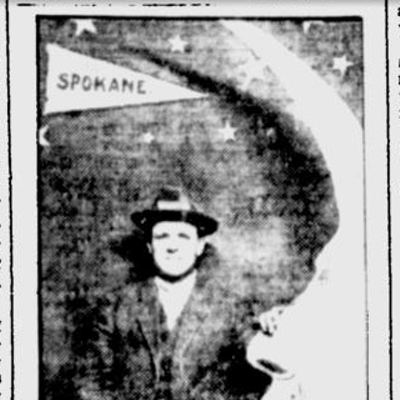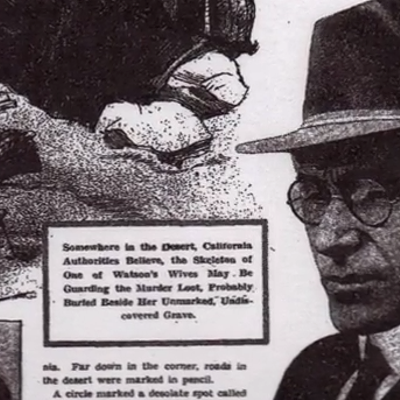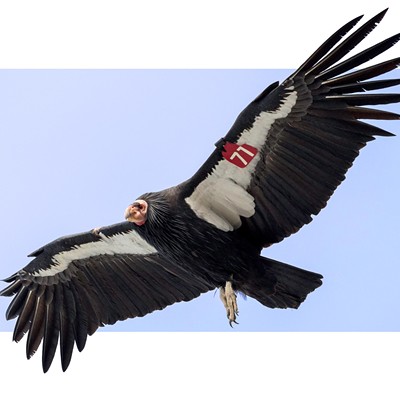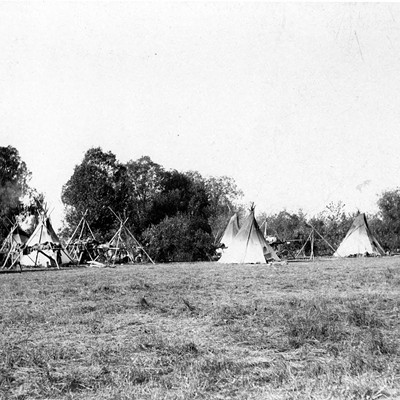All was quiet in Eastern Washington and the Columbia country for much of the day on December 14, 1872. In trading posts and tribal villages, people went about their usual business in the near-solstice darkness. Late in the evening, however, the most solid reality for those spread across the vast Columbia Plateau — the earth itself — rumbled and shook and rolled like the sea. The Walla Walla Union later published a letter written by the Honorable W.P. Winans of Colville about that evening:
"Our valley was visited by an earthquake at 10 1/2 o'clock P.M. The first shock lasted about three minutes, stopped clocks, shook down crockery and bottles from shelves, etc. Several slighter shocks occurred during the next five hours.
"The weather is cold, and sleighing good."
Mr. Winans' letter, complete with a calming sleigh ride, stands as one of several brief first-hand accounts of the shake. A dispatch from Spokane Bridge — a settlement just downstream from the current Plantes Ferry Park — assured friends in Walla Walla that four distinct tremors had hurt no one. Reports from Walla Walla, Umatilla and The Dalles described between two and five heavy shocks around 10 pm. Columbia River steamboat captain J.C. Ainsworth wrote that the event at Wallula Gap was followed by "five lighter shocks at intervals of about fifteen minutes, after which a heavy, rumbling sound was heard as distinctly as a heavy peal of thunder ... Although the first shock was violent enough to shake buildings and their contents up pretty lively, yet no damage or injury was sustained by any one, that I am aware of."
People in towns as far east as Henry House, Alberta, and Virginia City, Mont., felt the quake as a succession of mild shocks. Newspapers in the coastal cities of Portland, Olympia, Steilacoom (Tacoma) and Victoria, B.C., described changes in the waves at sea. A report from Chilliwack, upstream on the Fraser River, recounted, "The houses commenced to oscillate; the earth rose like waves of the sea; the rivers splashed their banks; horses neighed and cattle lowed. No loss has been sustained save the displacing of some fencing."
After the turn of the new year, in a succession of articles from newspapers around the Pacific Northwest, more dramatic stories came to light. According to the Dalles Mountaineer of January 4, 1873, "The Indians on Rock Island [just below Wenatchee] say the mountain at that place rolled down and killed three persons. On the Snoqualmie Pass the shock was so hard as to shake a man off his feet."
Some reports described a huge slide near the mouth of the Entiat River that had blocked the entire Columbia River, creating a dry channel and forming a lake that stretched north to the Methow River. Purported eyewitnesses swore that cabins had been shaken to pieces, chimneys twisted and collapsed; that Mount Rainier had let off a smoke plume that blanketed Eastern Washington, and children had suffocated from breathing sulfurous fumes. Many of the wilder accounts emanated from the vicinity of Lake Chelan, including geysers, waterspouts, rhythmic waves and tainted water near the lake's outlet.
Separating Fact From Fiction
Over the next few decades, various anniversaries of the quake were marked with commemorative coverage that tended to embroider rather than illuminate the truth. In time a whole body of conflicting stories passed into local lore, burying the facts of the earthquake beneath a haze of confusion and myth.
Then in the early 1970s, in order to determine the stability of some of their proposed sites for nuclear plants, the Washington Public Power Supply System (WPPSS) commissioned a geologic study of the 1872 earthquake. The lead author on the WPPSS report was Howard A. Coombs, a respected geologist whose team did an exemplary job of correlating period newspaper accounts and some tribal stories with modern geology, stratigraphy (the study of rock layers) and soil science. While Coombs' 1976 report debunked many of the second- and third-hand accounts that appeared in newspapers around the region, it left no doubt that a major earthquake had shaken the Inland Northwest, and that significant aftershocks were felt over a large area for some time afterwards. The quake's epicenter appeared to be somewhere along the east front of the Cascades near the Canadian border, a sparsely populated part of Washington Territory that at the time lay far from any newspaper.
Even given that there were few permanent buildings near the epicenter of the 1872 earthquake, reports of structural damage seem surprisingly light. There are tribal stories from the Sanpoil-Nespelem region of cracks appearing in the walls of pit houses, causing water to flood some families' winter dwellings. The Coombs report noted that the gristmill built in 1828 by the Hudson's Bay Company at Meyers Falls (modern Kettle Falls) is not mentioned in any newspaper account of the quake. Known to be in bad condition, the mill was rebuilt in 1873. Other contemporary accounts describe the displacement of the roof on the Miller-Freer trading post in Wenatchee and a chimney falling at Lake Osoyoos, as well as reports from surprisingly far away that included damage to walls at the Clarendon Hotel in Portland, the lighthouse on Dungeness Spit "badly cracked" and the front of a brick building in Victoria "cracked from cellar to garret."
A spring 1873 interview from the Whitestone area, on the Columbia just downstream from the mouth of the Spokane River, provided an eyewitness account from much closer to the epicenter:
"Mr. Covington, who has a trading post at White Stone ... informs us that he spent the Winter in that country, and was there at the time of the earthquake last Fall. He says that he counted ONE HUNDRED AND FORTY-TWO DISTINCT SHOCKS continuing at irregular intervals for forty-two days. At one place he saw a crack in the surface of the earth which is now open for about one hundred and fifty yards in length, and is from two to three feet wide at the top, and is from two to six feet deep. At another place he saw where the bank of the Columbia river had CAVED OFF AND SETTLED DOWN for two or three hundred yards. The mountains and cliffs were so shaken up and appear to be so greatly agitated and disturbed that large masses of rock are still constantly falling, tumbling and sliding down."
The further Mr. Covington's account wandered from Whitestone, the more fanciful it became, and all-caps dividers described the "COURSE OF THE COLUMBIA CHANGED," the appearance of "A BOILING LAKE," the way "DENSE SMOKE" covered the land, and finally the creation of a "NATURAL BRIDGE" over the Columbia at Fort Shepard, just north of the international border. The truth of these last four headings was impossible to verify, but by carefully dating discontinuities in nearby landforms, Dr. Coombs and his cohorts confirmed that significant landslides had occurred around the Whitestone trading post. Their geologic work only confirmed stories that modern Coeur d'Alene tribal member Cliff SiJohn heard when he was a child, describing how, within the memory of tribal elders of the 1940s, places around the mouth of the Spokane River sank during a night of shaking.
Blocked Rivers and New Geysers
Similar slumping may well have affected the unstable Ringold clay formations along the White Bluffs section of the Columbia River, opposite the modern Hanford Nuclear Reservation. Anyone who floats the Hanford Reach section of the Columbia today can see landslides of all sizes along the base of the bluffs. The presence of a healthy population of spawning chinook salmon on the Reach, in direct proximity to growing agricultural irrigation above the bluffs, make the hydrology and movements of the White Bluffs a closely monitored geologic process. All studies indicate that such landslides have been taking place for thousands of years, and although some of them could certainly have been touched off by area earthquakes, no direct correlation to the 1872 event has yet been made.
A little more than 100 miles upstream on the Columbia, however, the raw power of 1872 quake is clearly visible at Earthquake Point, just north of the mouth of the Entiat River. It was there a section of the massive Ribbon Cliff slid into the Columbia and temporarily blocked the main stream of the entire river. Tribal accounts tell of a family whose camp lay downstream from Ribbon Cliff, and of a woman who went down to the big river every morning to dip out water for cooking. On the day after the quake she was startled to find the entire riverbed dry. Wapato John, a headman of the Chelan/Entiat band who farmed upstream from Ribbon Cliff, described the river rising 50 feet overnight, covering his fields and trading post before breaking through the temporary dam and sending a pulse of fast water downstream. The Coombs report confirmed these stories of a major landslide and river blockage along that stretch of river, and Ribbon Cliff remains clearly visible at a spectacular geologic interpretive site along Alternate Highway 97 south of Lake Chelan.
Because the geology of Lake Chelan has long been a subject of scientific study, Coombs and company found several aspects of earthquake phenomena there that dovetail into some of the stranger earthquake tales. Odd waves and disturbed water were reported from the west side of the Cascades after the Dec. 14 quake, in places as diverse as Chilliwack on the lower Fraser River ("The rivers splashed their banks") and Puget Sound, where "the brig Fauntleroy, afloat in the lower bay, the shocks ... were perceptible by the vessel sinking deep into the water." Geologists call such water movements "seiches," and recognize that they can provide clues to long period communication along tectonic faults.
Lake Chelan is a deep, narrow body of water that has long been known to be prone to such disturbances; one of the most famous was a "volcanic upheaval" on the lake's surface observed only 20 minutes after an earthquake of 8.6 magnitude struck Yakutat Bay Alaska in 1899. Such violent seiches are often described as waterspouts or geysers, both of which were noted at the lake after the 1872 event.
Other accounts from "near the lake" tell of the earth subsiding up to five feet in one place, and of cracks opening up in the ground. Some of the cracks spurted water two or three feet into the air and reeked with sulfurous fumes. Coombs noted that at the southern end of Lake Chelan, lake bottom sediments consisted of glacial outwash more than 400 feet thick, and much of it would have been washed down from the region of the Holden copper mines, where sulfide mineral deposits were known to be abundant. He theorized that shifts in the ancient mud combined with hydraulic pressure could have easily rerouted the water patterns of the area, and created small geysers that would emit stinky fumes.
In 1922, The Wenatchee World printed an account by local tribal member Peter Wapato (son of John) that clearly described these effects:
"At Chelan Station a great hole opened in the earth and a veritable geyser was thrown into the air to a height of 20 or 30 feet. For weeks the Indians from all parts of the country came to see the strange phenomenon ... The geyser continued all winter but got weaker and as time went on it subsided. Springs in this location still remain to show the place where there occurred this remarkable water spout."
This happened in the area where the outlet of Lake Chelan feeds into the Columbia River, which today comprises Beebe Springs State Park. Except for the geyser, all the elements described by Coombs and Peter Wapato remain in evidence there.
The Coombs Report compiled four volumes of information from around the Inland Northwest. Taking it all into account, the team concluded that the 1872 earthquake ranged in force from 7.0 to 7.3 on the Richter scale and was centered some miles north of Lake Chelan. The extreme depth of the quake's epicenter, estimated at 40 miles below the earth's surface, resulted in the kind of long, slow shock waves that often leave local buildings intact but were amplified on unstable ground much farther away. Such deep quakes can have a profound impact on rock formations, as testified by the collapsed portion of Ribbon Cliff.
Many aspects of this stunning natural event have yet to be systematically explored, and a comparison of tribal oral histories with careful geological fieldwork remains an avenue for study. In the meantime, Whitestone, the White Bluffs, Ribbon Cliff and Beebe Springs stand as indisputable evidence that even in the Inland Northwest, an evening visit from an earthquake can change the whole world.
SHOCK WAVES IN 1700
The seismic history of the Inland Northwest, which extends roughly from the Cascade Range east to the Rocky Mountains, has yet to be clearly described. Yet anyone who has felt or heard some of the numerous small earthquakes that have shaken Eastern Washington over the past few years can understand that there is much to learn about the relationship between our moderate fault zones and practical matters such as the Spokane aquifer, the storage of atomic waste, landscape history and local building codes.
The region west of the Cascade Range presents a very different story. Stretching from southern British Columbia to northern California, the area geologists call Cascadia straddles the boundary between two actively moving tectonic plates; it is far more prone to earthquakes and their effects. This physical reality, combined with the dense human population along the I-5 corridor, has driven the study of local geology there to an entirely different level.
Just how deep this story can penetrate is illustrated in a remarkable new joint publication of the U.S. Geological Survey and the University of Washington Press called The Orphan Tsunami of 1700: Japanese Clues to a Parent Earthquake in North America. Six authors, led by UW geologist Brian Atwater, have pooled their knowledge to connect a massive earthquake along the Washington coast with a tsunami of previously unknown origin that struck western Japan the evening of Jan. 27, 1700. They make their case in a series of consecutive double-spread color pages that compare period Japanese village documents and their accurate, beautiful maps; natural history from North America including sediments, tree rings and detailed native accounts; and the latest in mathematical modeling and computer graphics.
The result has something to appeal to fans of every aspect of Northwest history and science. On the American side, a page from the diary of legendary Indian agent James Swan recounts Makah leader Billy Balch describing a rise in ocean level that flooded across Waatch Prairie to make an island out of Cape Flattery for several days. "There is no doubt in my mind," wrote Swan, "of the truth of this tradition."
On the Japanese side, there is an account of fishermen sailing out into a strangely colored sea only to be washed back ashore on the crest of a tsunami wave that parks their boat in the crown of a pine tree -- an exact counterpart to Northwest Coast stories of huge waves carrying dugout canoes into the top of the rain forest.
In the libraries and record offices of coastal villages in eastern Japan, sleuthing researchers piece together precinct accounts and scroll paintings that clearly document the tsunami event of 1700. The wave came with no warning, and local officials who were familiar with earthquake-caused waves wondered about its origin.
The scientific research into that mystery began in Seattle in the early 1990s, with a growing awareness of the frequency of prehistoric Cascadia earthquakes. Geologists began to identify areas of sunken land up and down the Washington coast. Foresters examined the annual rings of burnished cedar stumps and confirmed that the trees died when the ground they grew on sank into salt water after an earthquake event very closely related to the 1700 event in Japan. By studying rings on Sitka spruce roots they were able to refine the date of that event to a few months between the growing seasons of 1699 and 1700.
Computer scientists assembled geological information to generate an animated simulation, complete with a website for those who like to see it run, that follows the shock wave of that long-ago earthquake across the Pacific. The event that caused the tsunami was gauged to be around a magnitude 9.0 on the Richter scale -- a monster on an order measured only twice in the 20th century. (The 1906 San Francisco earthquake was estimated to measure a magnitude 7.8).
Finally, The Orphan Tsunami authors anchor a "muddy forecast" about what this might mean for future quakes in Western Washington with a photograph of a dune tussock from Grays Harbor at low tide. Lines of buried soil in the dune show seven major earthquake events over the past 3,500 years, or about one every 500 years. They write:
"For now it is prudent to assume, simplistically, that the next great Cascadia earthquake has a one-in-ten chance of occurring in the next 50 years, and that it may attain magnitude 9."
While it remains impossible to predict earthquakes with any precision, the work of geologists like Atwater and his colleagues have forced west side communities to revise their earthquake building codes and tsunami evacuation routes significantly upward, and to understand that at some point our society will face the same forces as the tree-bound fishermen from stories on both sides of the Pacific. For people who needed a real-life comparison, the 2004 earthquake and tsunami in the Indian Ocean brought all the elements of The Orphan Tsunami to life. Now is the time for further research, education, and serious preparation.
THE PROPHETS
The 1872 earthquake struck Eastern Washington during a time of great upheaval among the local native tribes. Although many bands and leaders had signed treaties with Gov. Isaac Stevens in the middle 1850s, many others rejected their terms. The 1858 war that followed those treaty signings was still fresh in everyone's memory, and in places like the Colville and upper Sanpoil valleys, removal of native peoples remained in a state of flux. Gold strikes on the upper Columbia and white settlers who were just beginning to filter into the region kept altering the boundaries and tribal makeup of the proposed Colville Indian Reservation.
In this kind of fluid environment, it is not surprising that the earthquake was seen as a significant spiritual event by many Columbia Plateau people. A Jesuit priest named Father Urban Grassi, who worked at St. Mary's Mission in the Okanogan, described the tremor as a sign from God. In an 1874 letter he commented about its effects on San Poil and Nespelim bands along the southern edge of proposed reservation:
"This tribe more than any other on the Columbia for past two years has been visited by God with earthquakes that in some places has sunk the ground, in others has piled it up greatly, and in others has broken the sides of the mountains. At the sight of such terrors, it is something new that this tribe, like its neighbors ... are beginning to fear and to pray, although the earthquakes have not caused them to abandon their vices entirely..."
While Fr. Grassi described the earthquake as helping his church to gain some new converts, there were many other Native American people who lived outside the influence of the Catholic and Protestant missionaries. When agent E.C. Kemble reported to the Secretary of the Interior in 1873, he included a list of no fewer than 10 different "dreamers" from the Inland Northwest, men who espoused their own versions of the more traditional tribal spiritual practices that Father Grassi considered "vices." On that list, Kemble counted followers who numbered from a few dozen to several hundred for each prophet.
Two of these dreamer-prophets, the Wanapum Smohalla and the San Poil Skolaskin, were said to have predicted the 1872 earthquake. Although many accounts of these prophecies are as fanciful as those of quake damage, their core was taken seriously by both natives and whites, especially in the case of Skolaskin. After carefully gathering a host of different versions of his story, anthropologist Verne Raye wrote that Skolaskin had apparently ridden into the the camp of a rival Okanagan prophet some weeks before the quake and declared, "the Manitou is angry with the wickedness of his people ... The land is going to shake. Buildings will fall down. People will go out of their heads. You had better tell your people. Warn them as to what is going to happen."
After the 1872 earthquake, most of the Okanagan prophet's followers had switched their allegiance, and Skolaskin continued gain in power and influence. He ordered a small church built in his home village of Whitestone -- one of the places most affected by the earthquake -- and for years held regular services there.
An 1889 story in the Spokane Falls Morning Review, under the headline "HOW HE FRIGHTENED HIS PEOPLE AND BECAME AN ABSOLUTE MONARCH IN WASHINGTON," recounted Skolaskin's career as being built upon his prediction of the great quake, and described him as a thorn in the side of local Indian agents:
"Within the past two years he has stopped gambling and drinking among his people, has organized a police force and equipped them, and has built a jail which he keeps filled with offenders. He is independent and will accept nothing from the government."
In time Skolaskin's Whitestone church was dismantled and rebuilt in front of the main offices of the Colville Confederated Tribes at Nespelem, where it stands today as a monument to both his work and the seminal event of the 1872 earthquake.























